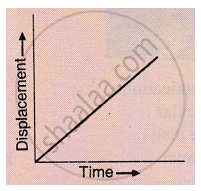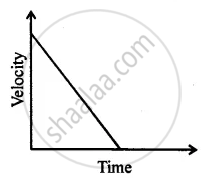Advertisements
Advertisements
Question
Describe the motion of a body which is accelerating at a constant rate of 10 m s–2. If the body starts from rest, how much distance will it cover in 2 s ?
Solution
We have to find the distance travelled by the body. We have the following information given,
So, Initial velocity, (u) = 0 m/s
Acceleration, (a) = 10 m/s2
Time taken, (t) = 2 s
We can calculate the distance travelled by using the 2nd equation of motion,
`s = ut + 1/2 at^2`
Put the values in above equation to find the distance travelled by the body,
`(s) = 0(2) + 1/2(10)(2)^2`
= 20 m
APPEARS IN
RELATED QUESTIONS
What conclusion can you draw about the velocity of a body from the displacement-time graph shown below :

Derive the formula s= `ut+1/2at^2` , where the symbols have usual meanings.
A freely falling object travels 4.9 m in 1st second, 14.7 m in 2 nd second, 24.5 m in 3rd second, and so on. This data shows that the motion of a freely falling object is a case of :
The figure shows the displacement - time graph for four bodies A, B C and D. In each case state what information do you get about the acceleration (zero, positive or negative).

When is the positive acceleration?
Multiple choice Question. Select the correct option.
At the maximum height, a body thrown vertically upwards has :
Can you suggest a real-life example about the motion of a body from the following velocity – time graph?

An object starting from rest travels 20 m in the first 2 s and 160 m in the next 4 s. What will be the velocity after 7 s from the start?
An electron moving with a velocity of 5 × 104 ms−1 enters into a uniform electric field and acquires a uniform acceleration of 104 ms–2 in the direction of its initial motion.
(i) Calculate the time in which the electron would acquire a velocity double of its initial velocity.
(ii) How much distance the electron would cover at this time?
When will you say a body is at uniform acceleration?
